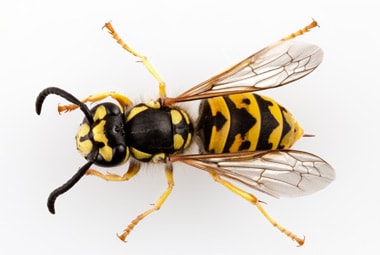
Yellow jackets are an aggressive species of stinging insect that are found throughout Missouri. Great care should be taken around nesting areas and they should not be disturbed. Yellow jackets are a beneficial species that are responsible for pollination and for helping to keep down nuisance insect populations.
| Pest Identification | |
|---|---|
| Recognition | Adult worker yellow jackets can grow to be between 3/8th and 5/8th of an inch in length. They have a hairless body that usually has a yellow and black banded pattern on it. Their face/head is usually black or yellow and their body is hairless. They have a thin defined waist and their wings are elongated and will fold laterally against their body when they are at rest. |
| Biology | A new yellow jacket colony starts each spring after the queen emerges from the spot that she has overwintered in. She searches until she finds a suitable area to create a paper nest and lay her first batch of eggs in. These first eggs will hatch and develop into worker females who are responsible for gathering food for the colony, increasing the size of the nest, and caring for the queen whose only job now is to lay eggs. By the end of the summer the colony is at its peak size and can have up to 5,000 members. During this time the queen will lay eggs which hatch into males and new queens. The males and new queens will mate and the new queens go off and find an overwintering site. The colonies current queen, males, and worker females will all die at the first frost and a new colony will begin the following spring from the new queens. |
| Habits | Yellow jackets are a species of social wasp that are responsible for some pollination but are mostly known for their predatory and hunting skill. They prey upon other insects and eat sweets and proteins that they come across. Yellow jackets are a common problem at large outdoor events where there is a lot of food and open beverage containers. They build paper nests out of a mixture of chewed up cellulose and saliva. They commonly build their nests in the ground but, if given the chance, they may place a nest inside of a building behind walls or in attics spaces. Yellow jackets have a smooth stinger and therefore have the ability to sting a victim over and over again increasing the amount of venom that is introduced into them. The venom from a yellow jacket sting can cause a severe allergic reaction in some people and they will require immediate medical attention. |
| Prevention | The best way to prevent problems with yellow jackets on your property is to have a year-round home pest control program in place. Along with a home pest control service, some other things that you can do to help prevent yellow jackets from building a nest in or near your home include: Trim back trees and bushes from your home, Make sure that outdoor trashcans have tight-fitting lids, Seal all cracks in your home’s foundation, Caulk gaps around windows and doors, Be sure that vent covers are secure. |
| Professional | If a yellow jacket nest has been built too close to your home or even inside of your home a Rottler technician can inspect your home and property to locate the exact location of the nest and deliver an appropriate treatment depending on the nest location. If the nest is located in the ground, the technician will find the entrance hole and introduce an appropriately labeled pesticide dust. If the nest is inside of your home the void where the nest is located will be treated and if possible opened up to remove the nest and dead insects. Each occurrence is evaluated and the best plan of action is determined based upon your actual situation. Yellow jackets can be aggressive and dangerous and therefore their nests should only be removed by a professional who has the experience and equipment needed to accomplish the task safely. |

